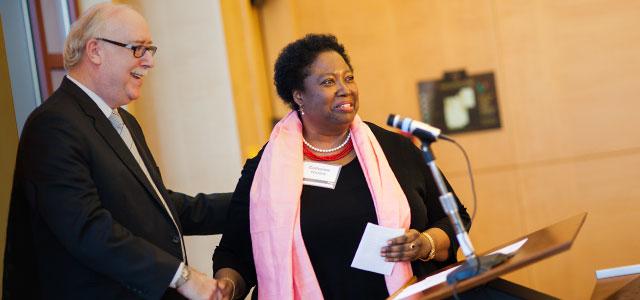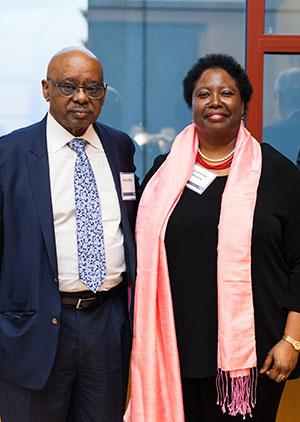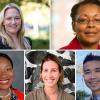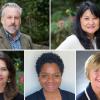
Dean David Vlahov introduces Catherine Waters at the Sally Bates Endowed Chair in Health Disparities induction ceremony (photos by Elena Graham).
Engaging Communities: A Conversation with Catherine Waters, Sally Bates Endowed Chair in Health Disparities
During two decades at UC San Francisco School of Nursing, Catherine Waters has pursued her community-based participatory research in collaboration with local civic and social organizations. Her wide-ranging work aims to reduce health disparities, with a particular focus on cardiovascular disease, cancer and diabetes.
SOC: Given its many challenges, why did you choose community-based participatory research in public health as your career path?
CW: It has to do with my childhood. I grew up in the South, Miami mostly, when the schools were being integrated. We were being bused, but the school district didn’t want to provide a school bus for the African American kids. Instead of talking about what the district was not doing or calling people racist, my parents asked what we could do as a community. Eventually, the entire community chipped in to charter a bus and pay for it that first year. The next year, the district provided a bus, but the incident helped me understand at a very young age what community really means – that sense that we’ve got to take care of each other. Yes, my parents taught me about personal responsibility as well, about how the world owes you nothing, but they also taught me it’s important to bring others with you so we can come together for solutions.
SOC: How does being selected as the first Sally Bates Endowed Chair in Health Disparities help advance your work?
CW: First, it’s a real honor to be selected because I have heard how Dr. Bates’ mother cared so much about the community and gave so much of her time without expecting anything back. To me, that’s what being a communitarian is all about.
I have not yet spoken with the dean [Dean David Vlahov] about this specifically, but what I propose to do first is support students who are interested in working in communities to address health disparities, whether it’s doing a pilot study, attending a conference or anything that gets or keeps them involved. This work is not glamorous, and it often takes a long time to get results – and we live in a society that values immediate gratification and an academic environment where you need to make a mark and make it fast. Each researcher and educator has to reconcile this with him- or herself, because this work sometimes means risking things like promotions and tenure. But students who are interested are always passionate about making a difference. They’re not delusional. They know it’s hard work, but there’s a small cadre that is very dedicated. I want to support those students, and the Bates Chair does send a message to many different communities – not just the students and faculty – that we as an institution are going to continue to reach out to address health disparities.
I also hope to use the chair to bring different people and groups together so we can coordinate our work. Researching health promotion and illness prevention in communities is very labor-intensive and time-consuming, and we often have to pick some piece of the puzzle and work on it and hope our puzzle piece fits with [the findings of] other people working on the same problems. But if we can coordinate better, we might be more effective. One successful example of this is my research partner, the African American Community Health Advisory Committee in San Mateo, which is a group of people – community researchers, educators, clinicians and community members – that has had a real impact over the last 20 years on people’s health.
I would also love to continue to establish private-public partnerships – departments of public health, private businesses working together around the physical activity and nutrition work that I do. They are a great way to get everybody involved to translate science and make it applicable to the community.
SOC: Despite progress in addressing health disparities, many challenges remain. How would you describe the biggest challenges remaining in research, education and service?
CW: Sometimes the policies and priorities that are set by people who we elect to run our society trickle down to education, research and service in terms of the funds available – and academia can be a microcosm of our society. There are so many social determinants of health that contribute to disparities, and they are all difficult to overcome, so when we don’t prioritize disparities, there are often not enough funds available to get the work done. Each of us ends up working in our silos, which can result in Band-Aid approaches, failing to get to roots and causes, whether those are poverty, education, access to health care services or living in houses and communities with environmental hazards.
 Ernest Bates and Catherine Waters Another challenge – although my colleagues may disagree – is that in academia, where there is such a strong focus on the next grant and getting publications out, I’m not sure we always take time to understand the data we do have. We have a hundred years of public health work, but we’ve really only seen infinitesimal progress. I think this is because we have to play the tenure track game and haven’t stopped to analyze and interpret, which leads to short-term solutions that don’t have a long-term impact.
Ernest Bates and Catherine Waters Another challenge – although my colleagues may disagree – is that in academia, where there is such a strong focus on the next grant and getting publications out, I’m not sure we always take time to understand the data we do have. We have a hundred years of public health work, but we’ve really only seen infinitesimal progress. I think this is because we have to play the tenure track game and haven’t stopped to analyze and interpret, which leads to short-term solutions that don’t have a long-term impact.
Finally, I think we have to continue to work to build the trust of the people we are trying to help – and this means genuinely including them in shaping what we need to study and bring to their communities. I was doing a project to reduce cardiovascular health disparities in highly affected zip codes here in San Francisco. I had what I thought was a great nutrition and physical activity program. But when I started talking with people, they told me what they were really interested in was learning CPR, because a kid in the neighborhood had just died because nobody knew CPR. So before I even tried to get them interested in my program, I got them CPR training, and it was only at that point that they were willing to talk about other needs.
SOC: What’s next for your work specifically?
CW: I have two projects in the works.
One has to do with end-of-life care planning and if there are ways to introduce it before people have a crisis. So we’re working with community members to explore the best ways to get these difficult conversations started, including working with people like lawyers and accountants, who might, for example, see memory issues before a doctor, because they see it in people suddenly making bad financial decisions. We’re also looking at a public health nursing model, with nurses who do home visits with our most vulnerable patients beginning these conversations. Essentially, we’re testing what the public would be receptive to, as well as how to deal with some of the myths.
In the other project, I’m partnering with a physician interested in trying to figure out if we can find better ways to deal with routine health issues, especially for people in underserved communities, who often have a hard time getting to see their provider. We’re looking at testing an app where you can describe your symptoms and send them to your provider, who would get back with advice or a prescription or maybe a follow-up call. We want to know how effective an app like this might be versus something like calling your provider’s nurse advice line. Who would be interested in using this?
While I’m still interested in working with individuals, I’m also at the point in my career where I’m very interested in looking at system-level issues, especially after five years of serving on the San Francisco Health Commission. That was really an eye-opener about how policies affect people at the grassroots level. I do believe there are people out there who want to come together to try to solve some of these long-term issues in health disparities, and I’m interested in finding a way to better exchange ideas and put all of our work together.



